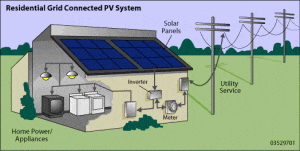Photovoltaic Systems (Solar Electricity)
Electricity can now be directly produced from the sun and converted for on-demand use in households. The systems available can be independent (stand-alone) of the main electricity supply grid or work in conjunction with your existing electricity supply. The system is made up of solar panels (photovoltaic panels), an inverter which converts DC power from the solar panels to AC power for household consumption and in some cases, batteries, which store electricity that is not immediately used.
a-simple-photovoltaic-system
While this technology is still relatively new to South Africa, advances in technology abroad have seen complete roofing systems with an integrated photovoltaic system plus a solar thermal water heating system. Glazing (windows) can now also be purchased with integrated energy producing photovoltaic cells.
Whilst there are currently no incentives from local and national energy bodies for the installation of photovoltaic systems, if international trends prevail, we will see local councils buying electricity back from homeowners at premium prices in the future. This system allows the homeowner to capitalise on such an event, generating extra income for the homeowner.
What you need to know:
A photovoltaic system is also known as a ‘PV’ system.
The electricity produced is free of carbon emissions and requires very little maintenance.
The performance of the system is based on location and the amount of daily sunlight.
The panels can be positioned on the roof or ground or both.
Panels have a solar orientation facing north.
The number of solar panels relates directly to the amount of electricity produced. An assessment must be carried out on the amount of electricity consumed on a monthly basis to determine the size of the system required.
The system is silent – there are no moving parts.
The life span of PV panels can be up to 30 years.
The system has a high ‘upfront’ cost but this is set to change as advancements are made in technology and production methods.
The system must be installed by an accredited professional in order that performance is optimise and warrantee’s are honoured.
Make sure that the panels are safely isolated in order to prevent the generation of potentially lethal Direct Current (DC) voltages throughout the panels and the associated wiring. If the panels are not properly isolated, the panels pose a risk to health and fire safety of the household.

